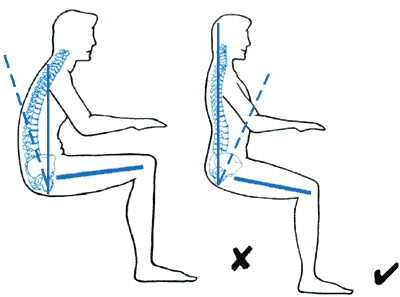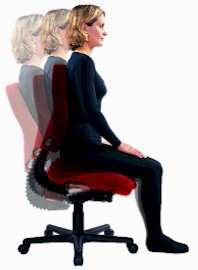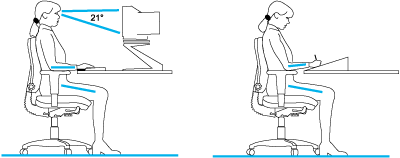Positive Health Online
Your Country

The Vital Role of Seating in Back Care
listed in back pain, originally published in issue 50 - March 2000
You are probably sitting down to read this and in the process of sitting down you have handed over a large amount of responsibility for your posture, spine shape and well being to whatever it is you are sitting on. What you may not realise is just how much responsibility you have handed over.
Do you suffer from the occasional ache in your neck or back? Should you expect these pains to arrive as part of your daily work? The answer to this last question is of course no. But why should it matter what we sit on and for how long? These are the questions we will explore as we look at the importance of seating.

Figure 1 (Left) Unhealthy sitting position: pelvic crest leaning back, strained spinal column, lower abdomen compressed and breathing and circulation restricted
Figure 2 (Right) Healthy sitting position: pelvic crest rotated forwards, spinal column extended, circulation and breathing unrestricted and less strain on the back}

Figure 3 Opera Chair: movement of the chair follows the body, feet stay on the floor, continuous back support

Figure 4 Sitting while working: For computer work – lengthen spine into its natural balanced position keeping head over shoulders, tilt seat forwards, screen should be at arms length and at eye level. For writing – lengthen spine into its natural balanced position keeping head over shoulders, tilt seat forwards, keep elbow above desk top and use a writing slope
We all take sitting for granted; indeed it would be unusual if we questioned 'how to sit'; after all how many of us were taught how to sit at school? Do you remember? In the past it was considered important to sit with one's head upright and shoulders back and to 'deport one's self properly'. I am not advocating a return to those days of practising sitting with a book on one's head!
However, I am trying to point out, that as a designer and manufacturer of office seating who has specialised in alleviating back pain for eleven years, what we sit on, and how we sit on it are both equally important for the well being of the body. For example, if you have developed round shoulders and a semi-hunched posture you will naturally feel good in a chair that reflects that posture, because it holds your body in the style to which you are accustomed. You feel okay sitting this way until… a new ache in a part of your upper or lower back, that has never been present before, makes itself known. Why should that be?
Problems Created by Poor Seating
Until quite recently, most office chairs have provided the sitter with a seat angled three to five degrees back. This makes the sitter sit back into the chair, automatically supporting the lower back. While mechanical keyboards were in use this had little or no impact on one's posture, but with the advent of electronic keyboards, which lessen movement of the upper part of the body, a 'worst case' scenario in postural terms (for sitting) has been created, ie. the 'upper body slump'. Look around the office at your colleagues working at their computers, see how 'hunched' they become at their desk in the afternoon.
Of course, as the day wears on one is bound to feel the effect of workload and one tires. The head starts to drop and we assume a more slouched posture. Add to this the effect of gravity on us whilst sitting. The facts are well documented on how much we shrink during the day. As much as 4cm in spinal height can be lost, through the effect of gravity on our intervertebral discs, the 'shock absorbers' between the vertebral bones in the spine. As our spine reduces in length the vertebral joints come into greater contact, muscles shorten and there is an increased chance of spinal nerves becoming trapped.
Repeated shortening of the supporting musculature can lead to a more flexible group of muscles initiating movement, muscles that would not normally be used to perform the task. This situation is biomechanically unsound for the body. To use the correct terminology, 'dynamic imbalances' in our body musculature are created, which can cause musculoskeletal pain syndromes, which are movement related. Imbalances from sitting can become semi-permanent, or even permanent.
For example, by unconsciously adopting a high-risk (slouched) posture at work, one's head can in time become habitually held forwards and one's shoulders rounded, and this position will persist when standing. A movement imbalance once generated can in time lead to a new site of pain being generated.
If we are not taught how to sit, or attempt a healthier habit towards sitting, we are vulnerable to developing many postural movement imbalances.
It all sounds very technical, and you may be asking yourself how this can possibly have any bearing on you. Let's try an experiment. If you are fortunate enough to have an office chair which allows you to change the seat tilt and it is set tilted up, try setting the seat to a level position (checking the seat surface by eye will be sufficient). When you sit back it will now feel different, even uncomfortable, because you feel that the chair is throwing you forwards off the seat, even though you know you have set the seat level. You are experiencing the effect of your own muscular imbalance on your sensory perception of body posture. If you are fit and well you can allow yourself to sit with the seat level for quite short periods of time during each day. You will be amazed at the change in your perception at the end of the first week. What felt normal before will begin to feel unnatural and what was odd will now seem normal.
Body-know-how or kinesthesis is the study of movement in relation to our body's muscular skeletal system. It takes time to make semi-permanent postural changes to our body, so it will take time for any correction to occur.
Features Required for Improved Posture
There are many claims by seating manufacturers that their chair is best with this feature or that adjustment, so how should you decide?
To change posture will involve changing the position of your chair seat and backrest. Can you do this in your office chair? Do you know how to use the control handles? Are they easy to use? Are the seat and back supporting you correctly? These are all key points.
The first simple rule when sitting is to sit well back into the chair so that your pelvis is supported (unless you have been taught how to sit unsupported). In other words, do not 'perch' on the front edge of your seat. Sadly, if this basic rule is ignored, or never learnt, lower back problems can result years later purely from poor posture.
How can the design of the chair upholstery affect your posture? Support for the pelvis and its angle is important, as this is the foundation for your spinal column whilst seated. Lumbar support can be either a benefit or a liability depending on the accuracy of its location. As a liability it can be missing from a chair or, as is more commonly found, be positioned in the wrong place, ie. set too high or too low against your lumbar curve.
If you are not sure which location suits you best, this is a good sign, as it means that your back is okay. If, however, you are acutely aware of a lumbar support being in the wrong position this is positive feedback from your body. 'Listen' to your body and adjust the height of your chair backrest until you feel comfortable with it, ie. usually about the belt line. Ideally, the lumbar support in the backrest should completely fill your lower lumbar curve, but equally it must not be too large so as to push the spine into an even deeper curve. An adjustable lumbar support is therefore not so much a luxury as a sensible addition to a chair.
Support for the shoulder blades has much to do with preference. Unless you use a reclined posture you may not feel the need for a high backrest, however, if you have been used to a tall backrest you may feel a lack of support when using a less high back.
Over-support in the upper backrest region will not allow you ease of movement from side to side and may even encourage shoulders to become rounded. It is important to be able to sit upright; the backrest should not prevent this, but should still give support along the length of your back. The head is heavy and therefore should remain upright 'balanced on the top of our spine'. A chair that prevents you from achieving this should be avoided.
A neckrest or headrest should not normally be necessary,but if present, ought to fit accurately in the small of the neck or at the base of the skull as appropriate. For computer users, these can be useful in situations where there is a neck injury, but they tend only to be needed for relief when the chair is in a reclined position, and not whilst actively keying. With neck problems, the seat angle and pelvic position are crucial and tend to be dictated by the position in which the neck is most comfortable.
Be warned though – even having a well-designed, fully adjusting office chair, set with the seat level to allow a natural, balanced, upright posture, is not always enough to avoid problems. The chair should fit you; it should be neither too large nor too small and selected according to your body dimensions.
It is important that there is a small gap between the front edge of your chair seat and the back of your leg. If a chair seat is too long, the back of one's legs will make contact with the seat. This will create pressure in the leg when you attempt to sit back in the chair to support the pelvis. Unwanted pressure behind the knee reduces the supply of blood to the legs and 'pinches' the popliteal nerve located there. The result can be a swelling of the legs and back pain. A seat that is too wide will not allow you to support your elbows, should you wish to without leaning over to one side, thereby twisting the spine.
Lastly, movement is of vital importance for the body's well being. Studies have shown that as little as 20 minutes in one sustained static position, which is easily achieved when working at a computer, will have an effect on muscle performance which can take 40 minutes or more from which to recover. The implications are two-fold: firstly, muscles become tired, and secondly, excess unwanted pressure may be generated in a skeletal joint. With constant 'static' loading, ie. staying in one position for too long, the tone and therefore the length of muscle can alter permanently to the detriment of the joint. Ideally, every chair should be fitted with a balanced rocking action to allow the body relief from static loading and to reduce fatigue.
There are other powerful physiological reasons for learning to change one's sitting posture and move frequently. By sitting with a more upright posture, breathing is less restricted. There is more efficient use of your diaphragm and the upper part of your chest, so more oxygen is circulating to keep the brain refreshed. Your lower abdomen is less compressed, so digestion is improved and circulation is not as compromised. Sitting upright can help you to keep your lower back strong; you will find that you have greater freedom of movement and reduced strain on the muscles of your upper and lower back.
I do hope that I have increased your awareness on how seating, through the effect on posture, can have a profound impact on your health over a period of time. Be careful of your first impressions when sitting in a new seat, and make sure that the chair fits you instead of you having to adapt to the chair.
Comments:
-
No Article Comments available